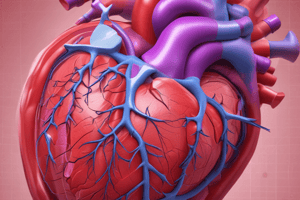Podcast
Questions and Answers
What is the most common type of ventricular septal defect?
What is the most common type of ventricular septal defect?
- Malalignment VSD
- Muscular / Trabecular VSD
- Inlet VSD
- Membranous / Perimembranous VSD (correct)
Which type of VSD is characterized by having a 'swiss cheese' appearance?
Which type of VSD is characterized by having a 'swiss cheese' appearance?
- Malalignment VSD
- Muscular / Trabecular VSD (correct)
- Outlet / Supracosm VSD
- Inlet VSD
Which condition is most closely associated with Down syndrome?
Which condition is most closely associated with Down syndrome?
- Inlet VSD
- Endocardial Cushion Defect (correct)
- Membranous / Perimembranous VSD
- Outlet / Supracosm VSD
What characteristic is true of the Outlet / Supracosm VSD?
What characteristic is true of the Outlet / Supracosm VSD?
What condition occurs when two portions of the IVS fail to align properly during development?
What condition occurs when two portions of the IVS fail to align properly during development?
Flashcards are hidden until you start studying
Study Notes
Ventricular Septal Defects
- A ventricular septal defect (VSD) is a hole in the wall between the left and right ventricles of the heart.
- VSDs occur when the interventricular septum (IVS) does not close completely during fetal development.
- VSDs are generally classified into six categories: Endocardial Cushion Defect / Atrioventricular Defect, Inlet VSD, Muscular / Trabecular VSD, Outlet / Supracosm VSD, Membranous / Perimembranous VSD, and Malalignment VSD.
Endocardial Cushion Defect / Atrioventricular Defect
- This type of VSD occurs when the endocardial cushions, which are structures that help to form the heart septa, do not develop properly.
- Endocardial cushion defects are commonly associated with Down syndrome (Trisomy 21).
- The defect results in a single common AV valve with a "butterfly" appearance.
Inlet VSD
- Characterized by a hole located near the AV valve, where "inlet" comes from (aka inflow).
- This type of VSD is bordered by the mitral valve (MV), tricuspid valve (TV), and muscle.
- Inlet VSDs are commonly associated with Atrioventricular VSD (common AV valve).
- Lytic activity occurs where the RV valves are located.
Muscular / Trabecular VSD
- Found in the thicker portion of the septum.
- Usually located near the apex of the heart.
- This type of VSD can have multiple holes that look like "swiss cheese."
Outlet / Supracosm VSD
- Occurs between the left ventricle (LV) and right ventricle (RV) outflow tracts.
- Bordered by the pulmonary artery (PA) and pulmonary valve (PV).
- Commonly associated with pulmonic stenosis and Tetralogy of Fallot (TOF).
- Higher prevalence in Asian populations.
Membranous / Perimembranous VSD
- Most common type of VSD.
- Bordered by the tricuspid valve, AV valve, and muscle.
- Located high up on the wall near the valves and great vessels.
- Extends and pushes with the right ventricle.
- Often small and flexible, denoted by the letter "L."
Malalignment VSD
- Occurs when two portions of the IVS fail to align properly during development.
- Frequently associated with other heart defects, such as TOF (Tetralogy of Fallot) and Truncus Arteriosus (T.A.).
Studying That Suits You
Use AI to generate personalized quizzes and flashcards to suit your learning preferences.




